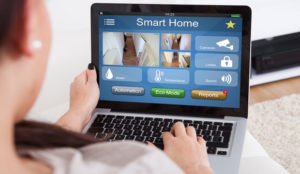Internet of Things cloud platforms offer device makers and companies the opportunity to greatly expand the value of products and services. These devices are reshaping the value chain by altering product design and development, manufacturing, marketing, supply chain management and service after the sale. They also generate new support activities, such as product data analytics and security.
While connectivity and cloud support require additional product costs for device makers, business value expands greatly — not only by adding value to the product, but also by extending the product’s lifetime through ongoing enhancements and feature expansion. The data cloud platforms provide can enhance virtually all areas of business.
Product Differentiation
Based on product differentiation, smart, connected devices open up competitive advantages that can elevate the consumer conversation above price alone. Convenience, remote control and monitoring, personalization, improved device and data security, and interoperability with other devices all can be differentiating factors for smart devices when compared to traditional nonconnected devices.
Increased product value may be captured in the following ways:
- Higher retail pricing
- More aggressive competition at the same price point
- Consumer bonding to a product ecosystem
- Monetization through value-added services
Product Development and Manufacturing
Cloud platforms enable a more agile, data-driven approach that allows iterative testing of new devices to accelerate the product development process and produce a more advanced product before market launch. Existing products can be enhanced or repaired through software and firmware updates without service calls or replacement. Also, pushing more processing requirements to the cloud can lead to reductions in hardware costs and simplified user interfaces.
New control features can be added at the application layer without any modification of the physical product. Lower product manufacturing costs can result in increased consumer adoption and improved overall margins. Cloud-supported devices can undergo A/B testing to see how a new product feature works and to see how consumers respond to it. This is a substantial benefit that gives the product development team the ability to conceive and manipulate features, as well as to measure results.
Supply Chain Management
The benefits of cloud-connected devices for supply chain management are not always obvious in the beginning, but once the device is turned on and connected to the cloud, the device maker knows that it is actively in use.
With production, distribution, and point-of-sale data, manufacturers can get a better sense of how long the supply chain takes and how much product is in the pipeline. Immediate feedback on actual sales can trigger orders in the supply chain, especially when retailer data is lacking or responsiveness is slow.
Device Optimization
The telemetry data analytics of cloud platforms provide manufacturers with a level of information previously unavailable in unconnected products. In the past, manufacturers knew how people used their products only through quantitative surveys or qualitative focus group interviews.
Connected device makers are learning, however, that if you compare consumer-reported product experiences to actual usage data recorded in the cloud, consumers may misreport or misremember their product interactions. Cloud data provides the most reliable record of consumer usage, and therefore enables better device optimization.
Product Customization and Personalization
Through virtualization of smart devices in the cloud, manufacturers can offer a variety of options for customizing the user experience, including configuring the control app, notifications and alerts; rules engines that trigger actions; and interconnectedness with other products.
With usage data and consumer profiles, manufacturers can be proactive in offering personalized experiences, content recommendations, configuration recommendations, or features based upon a user’s location, time context, or frequency of usage.
Great app experiences, from initial connectivity to ongoing control, create value for the manufacturer and the consumer. Poor app experiences can undermine the product experience, no matter how well-designed the physical product may be.
Marketing Analytics and Business Intelligence
The combination of device telemetry data with consumer profile and preference data gathered during the installation process enables smart product manufacturers to gain much deeper insights into customer interactions.
Business intelligence dashboards enable marketing personnel to segment the user base and analyze usage by a number of demographic lifestyle, and product variables. Analysis of usage patterns can lead to the development of new features or to the cancellation of unused features.
Assumptions about consumer preferences can be tested against actual usage, and segmented testing of application features can be conducted before they’re rolled out to the broader product population.
Big data analytics can be applied to integrate data from multiple sources — such as devices, weather reports, the energy grid, and customer GPS — to develop a premium service. An example would be a demand response energy management service offered by a smart thermostat manufacturer in partnership with a utility.
Interoperability Benefits
Making connected devices interoperable with others, either through peer-to-peer connectivity or integration with a home automation app or hub, expands their utility as well as their visibility to users of other device brands.
While many smart devices are point solutions at this stage in the Internet of Things, the emerging complexity and volume of devices in the home necessitate greater interoperability and simplified control platforms, rather than an app for every device.
E-Commerce Integration
Currently, most e-commerce integrations with smart device apps are merchandising links to external sites and are not embedded e-commerce experiences that allow customers to complete transactions in the app. With device use data, manufacturers can extend e-commerce offers for related consumables, such as appliance filters, laundry supplies, replacement bulbs, or repair parts and services.
Connected health, connected car, and connected entertainment platforms can facilitate similarly targeted in-app offers for related products and services — such as a weight loss program for health, automotive service for cars, or premium subscription for content.
Data gleaned from these platforms can be used to facilitate a device maker’s e-commerce operations, or to forge mutually beneficial e-commerce partnerships with those operating in the same space.
Improving and Extending the Customer Relationship
With consumer expectations increasing and customer experience becoming the differentiator for so many brands, cloud platforms can add value by improving and extending the customer relationship.
Cloud-supported customer service tools provide a means to receive, gather, analyze, and respond to events from connected devices. This extended customer relationship is a doorway for cultivating brand loyalty, conducting product education, extending personalized offers, and upselling or cross-selling related products and services.
The range of potential benefits demonstrates the degree to which cloud platforms have redefined many products from largely static, one-off devices to dynamic, data-gathering distribution systems for expanded services.
The shift from products as hardware to products as hardware with software and cloud support is bringing radical transformation to the processes of manufacturing, marketing, distribution and customer support.







































Social Media
See all Social Media